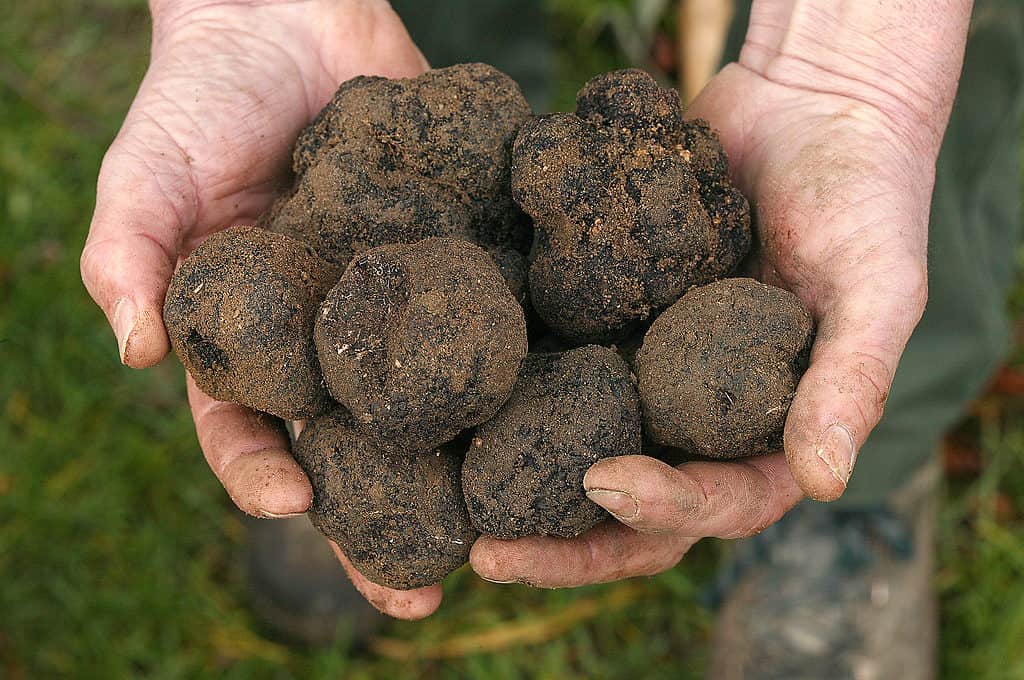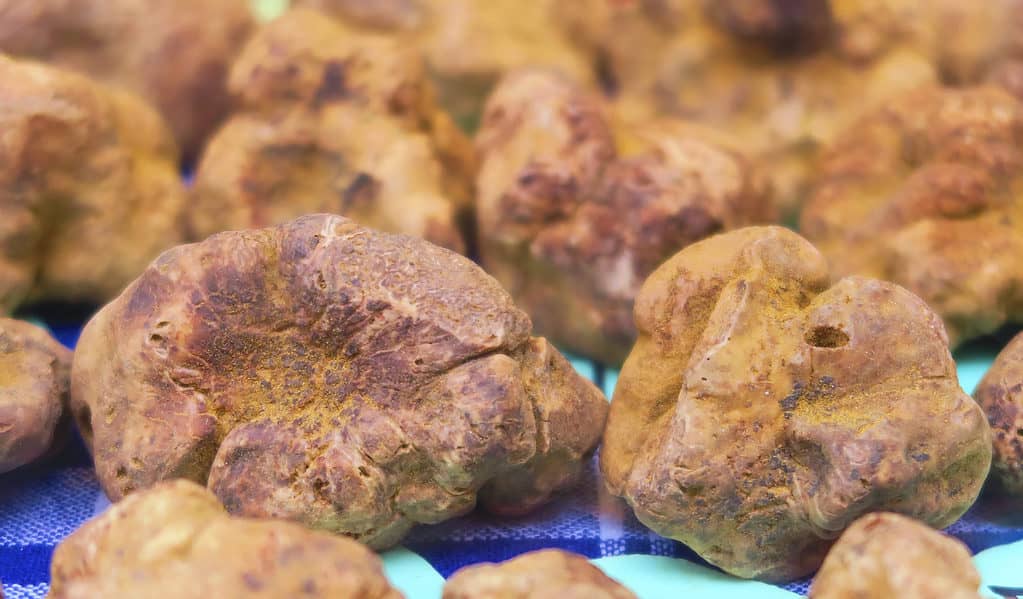If you’re an avid forager or fan of mycology, you may have noticed inconsistencies in how mycologists, mushroom hunters, field guides, and scientific literature describe truffles. Some may classify them as mushrooms, while others describe truffles as the subterranean fruiting bodies of certain fungi but avoid using the M word in their definition. So, what’s the correct answer?
In this guide, we’ll tackle the question of whether or not truffles are actually mushrooms. And as with much of the natural world, you’ll find that the answer isn’t as clear-cut as we may desire.
Read on to learn more!
Are Truffles Mushrooms: Defining Mushrooms
The answer to this question depends upon your definition of a mushroom. While we know that mushrooms describe some types of the reproductive fruiting bodies of some fungi, narrowing down the definition further can become tricky. Currently, the unscientific term “mushroom” does not have one widespread, academically accepted definition. Instead, there are a few definitions that mycologists and mycophiles may use to describe what falls into the category of a mushroom.
Perhaps the narrowest definition of a mushroom states that only the aboveground (epigeous), macroscopic fruiting bodies of fungi in the Basidiomycota phylum are mushrooms. Within this definition, you could not classify truffles as mushrooms. Additionally, the highly prized morels, which belong to the Ascomycota phylum of fungi, wouldn’t count as mushrooms either.
A broader definition includes all macroscopic, epigeous fruiting bodies within the Basidiomycota and Ascomycota phyla. This definition would include morels, but it still excludes the underground-fruiting (hypogeous) truffles.
Finally, one of the broadest definitions of a mushroom includes all epigeous and hypogeous macroscopic fruiting bodies within the Basidiomycota and Ascomycota phyla (together known as the Dikarya subkingdom). As macroscopic, hypogeous fruiting bodies within the Ascomycota phylum of fungi, truffles are mushrooms under this definition.
So, ultimately, you can come across scientific literature that may include or exclude truffles as mushrooms, depending on the definition used. In this guide, we’ll adopt the broadest of the given definitions to include truffles as mushrooms.

Under a broad definition that includes all macroscopic fruiting bodies of the Dikarya subkingdom, truffles are considered mushrooms.
©Sofia Royo/Shutterstock.com
Truffles: Classification
As mentioned above, truffles belong to the Ascomycota phylum of fungi. Mycologists describe organisms categorized within the Ascomycota phylum as sac fungi or ascomycetes. The name “sac fungi” describes the microscopic, sac-like structures of ascomycetes, called asci, that contain the fungus’s reproductive spores (ascospores). Ascomycetes are incredibly diverse and represent the largest phylum of Fungi with over 30,000 known species.
Within this order, truffles belong to the Pezizomycetes class, which contains a single order- Pezizales. The Pezizales order contains the vast majority of the mushroom-forming fungi in the Ascomycota phylum. This includes morels, cup fungi, and truffles.
Truffles belong to several families within the Pezizales order, including Tuberaceae, Pezizaceae, Pyronemataceae, and Morchellaceae. They are further categorized into over 100 genera and hundreds of species. Of these hundreds of species, only about 15 are of great culinary value to humans. Most of the gourmet truffles belong to the Tuber genus. Some exceptions include the sought-after Oregon black truffle (Leucangium carthusianum), the Oregon brown truffle (Kalapuya brunnea), and the so-called Blue Ridge truffle (Imaia gigantea).

The beautiful French black truffle (
Tuber melanosporum) is of great culinary value.
©slowmotiongli/Shutterstock.com
Are Truffles Mushrooms: Characteristics
While truffles feature a rich diversity of colors, shapes, aromas, textures, and tastes, there are some general presentations common among species. They typically grow 1-9 inches beneath the soil and are either round, irregularly round, spherical, or potato-shaped. The protective exterior layer of a truffle is called the peridium. The peridium may be smooth, nearly smooth, or quite rough and bumpy. You’ll find truffle peridium in various shades of cream, tan, yellow, brown, black, and red.
The interior of the truffle contains the spores and is called the gleba. Many species feature a marbled gleba with white veins. The color of the gleba changes as the spores mature. For example. the Appalachian truffle (Tuber canaliculatum) features a brick-red peridium, but the marbled gleba changes from off-white when immature to nearly black when the spores reach maturity.

The pecan truffle (
Tuber Lyonii) displays striking marbling inside.
How Do Truffles Grow?
While truffles look quite different from most mushrooms you’ll find growing in your lawn, they form via a similar process. Like other fruiting bodies of fungi, truffles form when the fungus is ready to reproduce. After all, the main purpose of a mushroom is to disperse spores to ensure the fungus continues to grow in new locations. Similar to the process of some plant seeds, the spore dispersal method of truffles is typically reliant on animals that unearth and eat the fruiting body. The need for an animal vector for spore dispersal is the reason why mature truffles produce such intense aromas and flavors, some of which humans highly prize.
While the fruiting body is typically the most visible portion of the fungus, it is only the reproductive structure of a larger organism. The other portion of the fungus- the filamentous, underground hyphal strands of the fungus, called the mycelium- lives on, spreading throughout the soil, acquiring nutrients, and sending up new mushrooms, long after an individual fruiting body decays or is eaten.
The mycelium of truffles is mycorrhizal, meaning they grow via a mutually beneficial nutrient exchange with the roots of various tree species. When the mycelium acquires enough nutrients via its mycorrhizal partnership, and when other environmental conditions are favorable, it’ll form the fruiting body we call truffles. When an initial mycorrhizal partnership forms, it typically takes at least five years before the mycelium begins producing truffles.

Truffles are the reproductive,
©dav76/Shutterstock.com
The photo featured at the top of this post is ©
The information presented on or through the Website is made available solely for general informational purposes. We do not warrant the accuracy, completeness, or usefulness of this information. Any reliance you place on such information is strictly at your own risk. We disclaim all liability and responsibility arising from any reliance placed on such materials by you or any other visitor to the Website, or by anyone who may be informed of any of its contents. None of the statements or claims on the Website should be taken as medical advice, health advice, or as confirmation that a plant, fungus, or other item is safe for consumption or will provide any health benefits. Anyone considering the health benefits of particular plant, fungus, or other item should first consult with a doctor or other medical professional. The statements made within this Website have not been evaluated by the Food and Drug Administration. These statements are not intended to diagnose, treat, cure or prevent any disease.
Thank you for reading! Have some feedback for us? Contact the AZ Animals editorial team.







